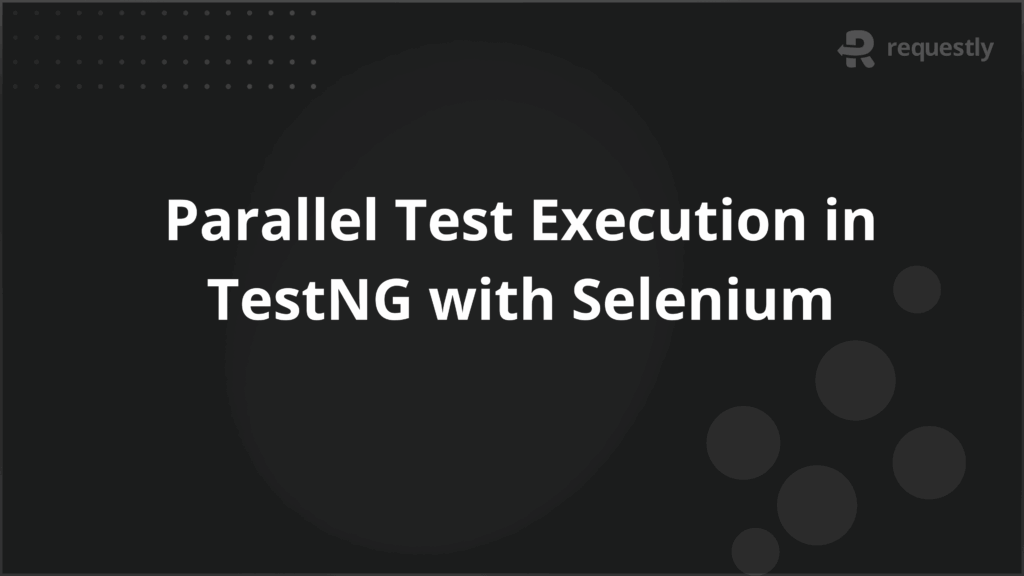Mastering GraphQL: Key Benefits, Architecture, and Best Practices for Testing


GraphQL has transformed the way developers interact with APIs by providing a flexible and efficient approach to data querying and management. Unlike traditional REST APIs, GraphQL enables clients to request exactly the data they need through a single endpoint, making applications faster and more responsive.
This article guides readers through the core principles of GraphQL, how it works, key common use cases, and best practices for testing and debugging GraphQL APIs.
What is GraphQL?
GraphQL is a powerful query language and runtime for APIs that allows clients to request exactly the data they need, no more and no less. Unlike traditional REST APIs, which often require multiple endpoints for different data needs, GraphQL consolidates these interactions into a single endpoint, enabling more efficient and flexible data retrieval.
It uses a strongly typed schema to define the structure of your data and the types of queries, mutations, and subscriptions that clients can perform. This schema acts as a contract between the client and server, ensuring predictable and consistent data exchanges.
GraphQL was developed by Facebook in 2012 and open-sourced in 2015. Since then, it has gained widespread adoption due to its ability to improve developer experience, reduce network overhead, and adapt easily to evolving data needs.
Its core components include a type system that models business data as interconnected objects, and resolver functions that fetch or manipulate this data on the server side. This design empowers clients to tailor their requests precisely, making GraphQL ideal for modern applications with complex, multi-source data requirements.
How GraphQL Works
GraphQL operates through a well-organized architecture that enables efficient data querying and manipulation with the following key components:
1. GraphQL Schema: Acts as a map of the API, defining the data types and relationships available to clients. It supports three main operations:
- Queries: Operations to read or fetch data
- Mutations: Operations to modify or write data
- Subscriptions: Operations to listen for real-time data changes
This structure enables clients to request exactly the data they need and interact with the API in a flexible, efficient way.
2. Resolver Functions: These act as the execution logic behind the schema fields. They:
- Fetch the requested data from various sources
- Perform any necessary data transformation or aggregation
- Enforce authorization and validation rules
- Ensure the client receives the correct and properly formatted response
3. Data Sources: These are the origins of the data that resolvers interact with, including:
- SQL and NoSQL databases (e.g., PostgreSQL, MongoDB)
- RESTful APIs and third-party services
- File systems or other remote data endpoints
- Allow GraphQL to unify diverse systems under one consistent API interface
4. Server Architecture: The deployment setup of a GraphQL server can vary, such as:
- Direct connection to databases for simple, tightly coupled APIs
- Acting as an aggregator layer above multiple microservices and APIs
- Hybrid models combining direct data access with service integration
- Provides scalable, flexible API design suited for evolving application needs
This architecture enables GraphQL to minimize over-fetching or under-fetching of data, optimize network usage, and provide clients with flexible, precise control over API interactions, making it ideal for modern, complex applications demanding real-time data and seamless integrations.
Key Benefits of GraphQL
GraphQL offers several powerful benefits that enhance API efficiency, developer productivity, and application performance, making it a preferred choice for modern data-driven development.
- Precise Data Fetching: Clients can request exactly the data they need, which eliminates the problems of over-fetching (receiving extra unnecessary data) and under-fetching (needing multiple requests to get all required data). This leads to more efficient data transfer and faster response times.
- Single Endpoint API: Unlike REST APIs that require multiple endpoints for different resources, GraphQL consolidates all requests to a single endpoint, simplifying client-server communication and API management.
- Flexible Queries: GraphQL allows clients to tailor queries dynamically. They can specify nested and related data in a single request, reducing the need for multiple round requests and minimizing latency.
- Strongly Typed Schema: The schema defines a clear contract between client and server, providing type safety and validation, which helps prevent errors and improves developer experience.
- Real-Time Data with Subscriptions: GraphQL supports subscriptions, allowing clients to receive real-time updates, which is essential for interactive applications and dynamic user experiences.
- API Evolution & Versioning: GraphQL APIs can evolve without breaking existing clients. Fields can be deprecated and removed gradually, avoiding the common versioning problems in RESTful APIs.
- Aggregates Multiple Data Sources: It provides a unified API layer over diverse backends, including databases, REST services, and microservices, enabling complex data relationships to be retrieved efficiently.
- Improved Performance & User Experience: By reducing over-fetching, minimizing network requests, and enabling precise data retrieval, GraphQL contributes to faster loading times and better performance in web and mobile apps.
GraphQL Architecture Overview
GraphQL architecture consists of several core components and flexible deployment approaches that enable efficient, scalable data querying and management:
Core Components
The core components of GraphQL architecture include:
- Schema: Defines the structure, types, and operations (queries, mutations, subscriptions) available in the API, serving as a contract between client and server.
- Resolvers: Functions that map schema fields to underlying data, fetching or manipulating data from various sources.
- Data Sources: Includes databases (SQL/NoSQL), REST APIs, and external services that provide the actual data behind the API.
Server Deployment Approaches:
These approaches include:
- Standalone GraphQL Server with Connected Database: A simple, direct approach where the GraphQL server interfaces with a single database, ideal for new projects requiring straightforward setups.
- GraphQL Server Integrating Existing Systems: The API acts as a unifying layer over multiple legacy systems, microservices, or third-party APIs, providing a consolidated interface without altering backend services.
- Hybrid Approach: Combines both direct database connections and integration with existing systems, offering flexibility to cater to diverse data needs in complex environments.
This modular and adaptable architecture makes GraphQL suitable for a wide range of applications, improving data access efficiency while allowing smooth evolution and scaling of APIs.
Common Use Cases for GraphQL
GraphQL’s flexibility and efficiency make it well-suited for various application scenarios, including:
- Mobile and Web Applications: Enables clients to fetch exactly the data needed, reducing bandwidth and improving performance on devices with limited resources.
- E-commerce Platforms: Allows flexible retrieval of product, inventory, and customer data in a single request, improving load times and creating better user experiences.
- Social Media Applications: Supports complex, nested data such as user profiles, posts, comments, and relationships, all retrieved through concise queries.
- Content Management Systems (CMS): Provides developers with an efficient way to query, update, and manage content with fine-grained control over data structures.
- Real-Time Data and Dashboards: Subscriptions enable real-time updates, making GraphQL ideal for live dashboards, notifications, and interactive user interfaces.
- Aggregating Multiple APIs and Microservices: Acts as a unified API layer that consolidates data from diverse backend systems, simplifying client interaction with multiple services.
- IoT and Device Data Management: Efficiently manages dynamic and varied data requirements across many connected devices with flexible queries.
These use cases demonstrate why GraphQL is increasingly adopted across industries demanding dynamic, scalable, and data-centric applications.
Getting Started: Sample Schema and Query
To begin working with GraphQL, it’s essential to understand how to define a simple schema and write queries to fetch data. Here’s a basic example using GraphQL Schema Definition Language (SDL):
Sample Schema:
type Book {
title: String
author: Author
}
type Author {
name: String
books: [Book]
}
type Query {
getBook(title: String!): Book
}
- The schema defines two object types: Book and Author.
- A Book has a title and an associated author.
- An Author contains a name and a list of books.
- The Query type allows clients to fetch a book by its title.
Example Query:
query {
getBook(title: "1984") {
title
author {
name
}
}
}
This query requests the title of the book “1984” and the name of its author.
How it Works:
- The client sends the query to the GraphQL server.
- The server uses resolvers to find the requested Book and Author data.
- The server returns only the requested fields, ensuring efficient data transfer.
This simple example illustrates how GraphQL schemas define the shape of data and how clients query that data flexibly in one request. From here, developers can build more complex schemas and queries tailored to their application needs.
Best Practices for Testing and Debugging GraphQL APIs
Effective testing and debugging are critical to maintaining the reliability and performance of GraphQL APIs, and applying the following best practices can help achieve these goals.
- Validate Queries and Mutations Thoroughly: Test all query and mutation operations for correct behavior, including valid and invalid inputs, missing fields, and argument types to ensure the API respects the schema rules and maintains data integrity.
- Test Edge Cases and Error Handling: Cover scenarios such as empty inputs, maximum/minimum values, authentication failures, and invalid queries to ensure the API handles errors gracefully and provides meaningful feedback.
- Performance and Load Testing: Assess how the API performs under heavy or concurrent requests. Use tools to simulate load, check response times, and ensure optimizations like query batching and caching are effectively applied.
- Check Authorization and Authentication: Verify that only authorized users can access or modify data by testing with valid/invalid tokens, different user roles, and permission levels. Ensure sensitive data is protected.
- Test Subscriptions for Real-Time Updates: Validate that real-time data streams work correctly by testing subscription connections, data changes triggering updates, multiple subscribers, and proper unsubscribe functionality.
- Use Schema Validation Tools: Automate schema checks to detect breaking changes early, ensuring smooth API evolution without disrupting existing clients.
- Automate Testing in CI/CD Pipelines: Integrate GraphQL tests to catch issues early during development and deployment cycles, enhancing overall API reliability and security.
Following these best practices helps ensure a robust, high-performing GraphQL API with reliable data integrity, security, and excellent user experience.
Ensure Effortless Mocking & Simulation with Requestly HTTP Interceptor
Requestly HTTP Interceptor provides a powerful, user-friendly solution to intercept, modify, and mock GraphQL API requests and responses in real time.
Unlike traditional REST tools, Requestly by BrowserStack handles GraphQL’s single-endpoint model by enabling dynamic filtering based on operation names and query content. This allows developers and QA teams to:
- Modify request payloads and simulate different server responses without altering backend code
- Mock GraphQL operations to accelerate frontend development and testing of incomplete or evolving APIs
- Simulate API delays to test application behavior under slow network conditions
- Redirect requests between environments for seamless testing of staging versus production
- Write custom JavaScript to dynamically override requests and responses as needed
- Collaborate easily with one-click sharing of HTTP rules for consistent testing setups across teams
By simplifying complex GraphQL mock and debugging workflows, Requestly ensures efficient development cycles and higher-quality API integrations.
Conclusion
GraphQL has revolutionized API development by offering precise, flexible data querying and efficient client-server communication. However, to fully leverage its benefits, rigorous testing and debugging are essential to maintain reliability, security, and optimal performance. Incorporating best practices such as comprehensive query validation, error handling, performance testing, and thorough authorization checks ensures robust GraphQL APIs that serve modern application needs effectively.
Tools like Requestly HTTP Interceptor further enhance developer productivity by simplifying real-time mocking, modification, and debugging workflows. Adopting these strategies and solutions empowers teams to deliver high-quality, scalable APIs that drive powerful user experiences in diverse environments.

Contents
- What is GraphQL?
- How GraphQL Works
- Key Benefits of GraphQL
- GraphQL Architecture Overview
- Core Components
- Server Deployment Approaches:
- Common Use Cases for GraphQL
- Getting Started: Sample Schema and Query
- Best Practices for Testing and Debugging GraphQL APIs
- Ensure Effortless Mocking & Simulation with Requestly HTTP Interceptor
- Conclusion
Subscribe for latest updates
Share this article
Related posts






















